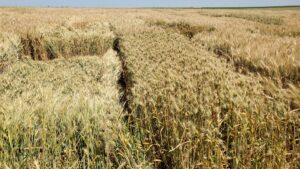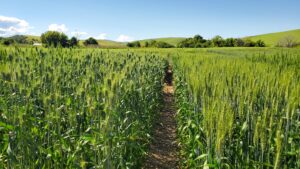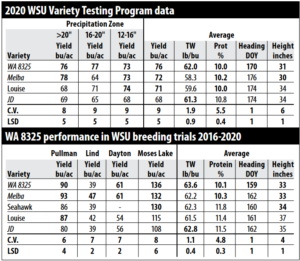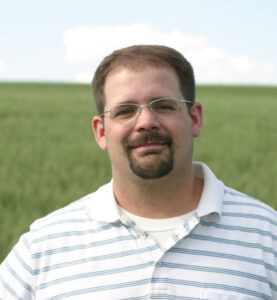By Michael Pumphrey
There are quite a few wheat growers in Washington state that are not afraid to voice their desires, concerns and opinions. Be it equipment, cultivation, weed control, crop rotation, fertility, soil health, fungicides, timing of operations, marketing, regulations or many other factors, the real art is in putting together a well-tuned system. Wheat varieties are a part of that bigger picture and interact with many of the other parts of the system.
As a wheat breeder who makes variety selection and release decisions, I rely on input from the wheat industry to make sure our variety development priorities are properly aligned. Grower, industry and public investment from the Washington Grain Commission (WGC), the U.S. Department of Agriculture, state and other funding is the lifeline that supports our efforts.
Similar to challenges that wheat growers face, the Washington State University (WSU) Spring Wheat Breeding program approaches statewide spring wheat improvement like trying to fill a barrel that is riddled with round holes, by using some square pegs and some hand-crafted solutions. Some focus and strategy are needed when breeding a rotation crop in a state with dramatic variation in environmental conditions, including soil, water, temperature, disease, cropping systems and at least four commercial market classes/subtypes of spring wheat. We try to fill the biggest gaps to make the barrel full.


Roger Koller from Mayview, northeast of Pomeroy, was an active advisor for the WSU wheat breeding programs. Roger passed away in December 2020 after a gritty battle with pancreatic cancer. The Kollers have hosted WSU variety trials and specific research projects for decades. As a multigenerational Coug family, they have high expectations for WSU in/on the field.
About 10 years ago, Roger very directly told me what was wrong with WSU spring wheat varieties, and what a new variety needed to be to help their operation. As a soft white common/club wheat grower, his thoughts were fixed on the need for a spring club variety with high (enough) yield, high test weight, Hessian fly resistance, stripe rust resistance and good threshing characteristics. He reminded me of this for the next several years as he endured existing challenges and also navigated club wheat market opportunities and saw some unusual seasons on their farm with severe stripe rust, low falling numbers, Hessian fly, lower test weights and low soil pH concerns.
For the Kollers and many other wheat growers statewide over the past 10 years, the focus of our small spring club wheat breeding effort has been to establish diverse, yet elite, germplasm with Hessian fly resistance; Hessian fly susceptibility was the most fatal flaw in available varieties. So, essentially all club wheat breeding materials that we have made were designed to bring in Hessian fly resistance. Substantial research in my program has focused on developing DNA tests to track Hessian fly resistance. Our focus on Hessian fly testing increased through collaboration with University of Idaho scientists, Drs. Arash Rashed and his predecessor, Nilsa Bosque-Perez, funded by the WGC. The toolbox has finally come together.
 In 2020, we included an experimental spring club wheat variety with Hessian fly resistance in the WSU Variety Testing Program trials, identified as “WA 8325.” WA 8325 performed head-to-head for yield with the best of soft white spring wheat varieties in each precipitation zone with greater than 12 inches of annual moisture, with test weight equal to the best and low protein. Notably, in the 16-to-20-inch precipitation trial locations, WA 8325 bested JD and Melba club variety yields by at least 12 bushels per acre across locations. These locations are where we often see the greatest Hessian fly impact. This variety will expand the area of reliable spring club wheat production due to Hessian fly resistance and may be grown in all areas of the state.
In 2020, we included an experimental spring club wheat variety with Hessian fly resistance in the WSU Variety Testing Program trials, identified as “WA 8325.” WA 8325 performed head-to-head for yield with the best of soft white spring wheat varieties in each precipitation zone with greater than 12 inches of annual moisture, with test weight equal to the best and low protein. Notably, in the 16-to-20-inch precipitation trial locations, WA 8325 bested JD and Melba club variety yields by at least 12 bushels per acre across locations. These locations are where we often see the greatest Hessian fly impact. This variety will expand the area of reliable spring club wheat production due to Hessian fly resistance and may be grown in all areas of the state.
WA 8325 maturity is on the early side and with very good adult plant stripe rust resistance. WA 8325 hit the marks that Roger Koller established and is higher yielding than existing club varieties in most trials to date, is earlier and has excellent club quality. To honor Roger’s input and support of WSU wheat breeding and variety testing, I believe it is very fitting and have received clearance to name WA 8325 “Roger” pending WSU release approval this fall.
Varieties like this reflect the unique partnership and investment of Washington wheat growers in WSU wheat breeding programs. There is not currently another source of spring club wheat varieties; the market is cyclical, and the spring wheat growing area is diverse, variable and requires local expertise. I am thrilled to be able to work in this industry to fill specific gaps and holes to make the barrel a little fuller.
This article originally appeared in the Aug/Sept 2021 issue of Wheat Life Magazine.

Michael Pumphrey, Ph.D.
Michael Pumphrey is an applied plant breeder that continues to be intimately involved in production agriculture. Pumphrey holds the O.A. Vogel Endowed Chair of Spring Wheat Breeding and Genetics at Washington State University and leads the spring wheat breeding and genetics program. His research is focused on development of biotic and abiotic stress tolerant, high-yielding, and high-quality spring wheat varieties for diverse Washington (Pacific Northwest) production environments. He also teaches one undergraduate crop sciences course and one graduate plant breeding and genetics course. Read more about Dr. Pumphrey.
